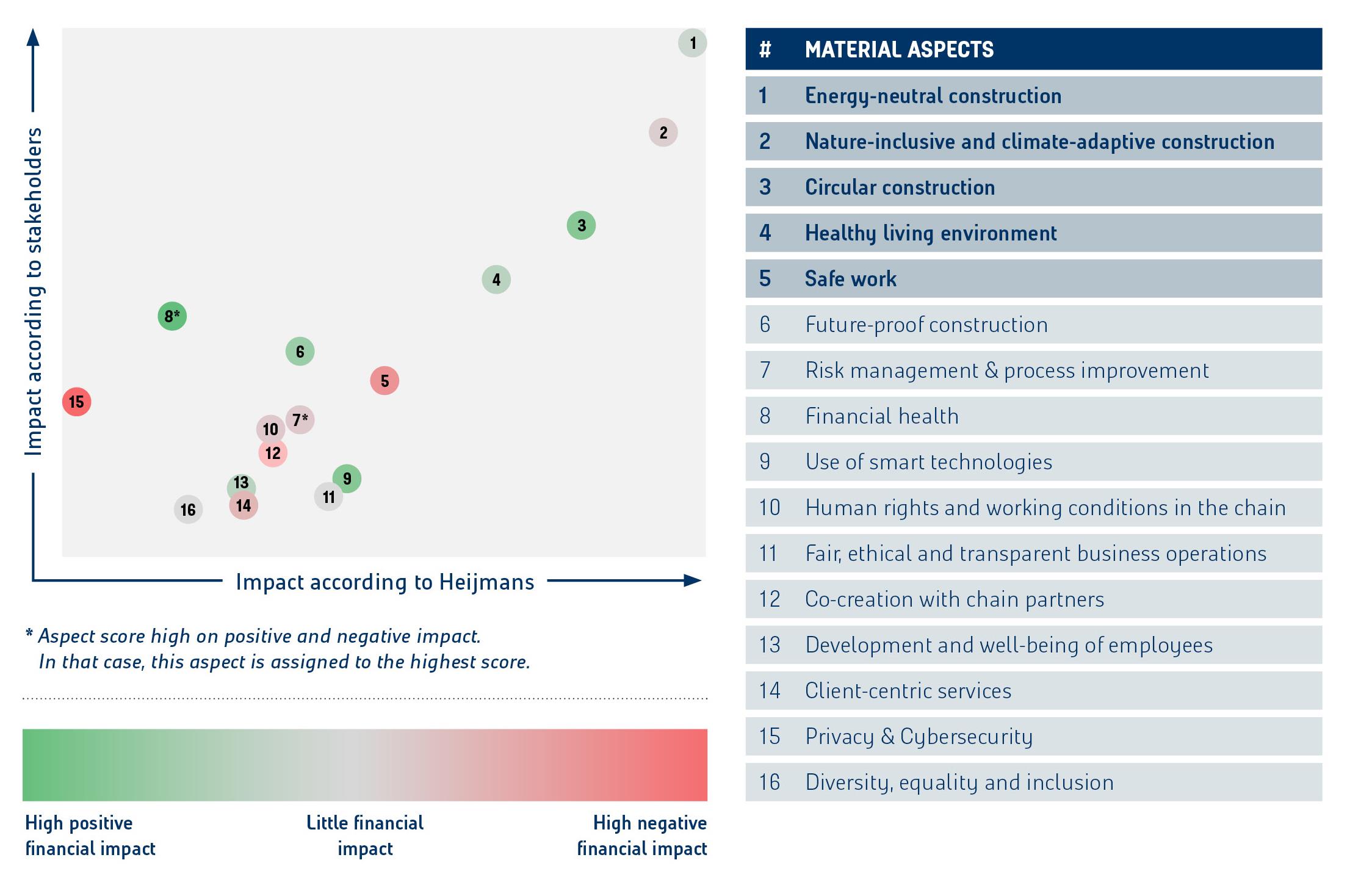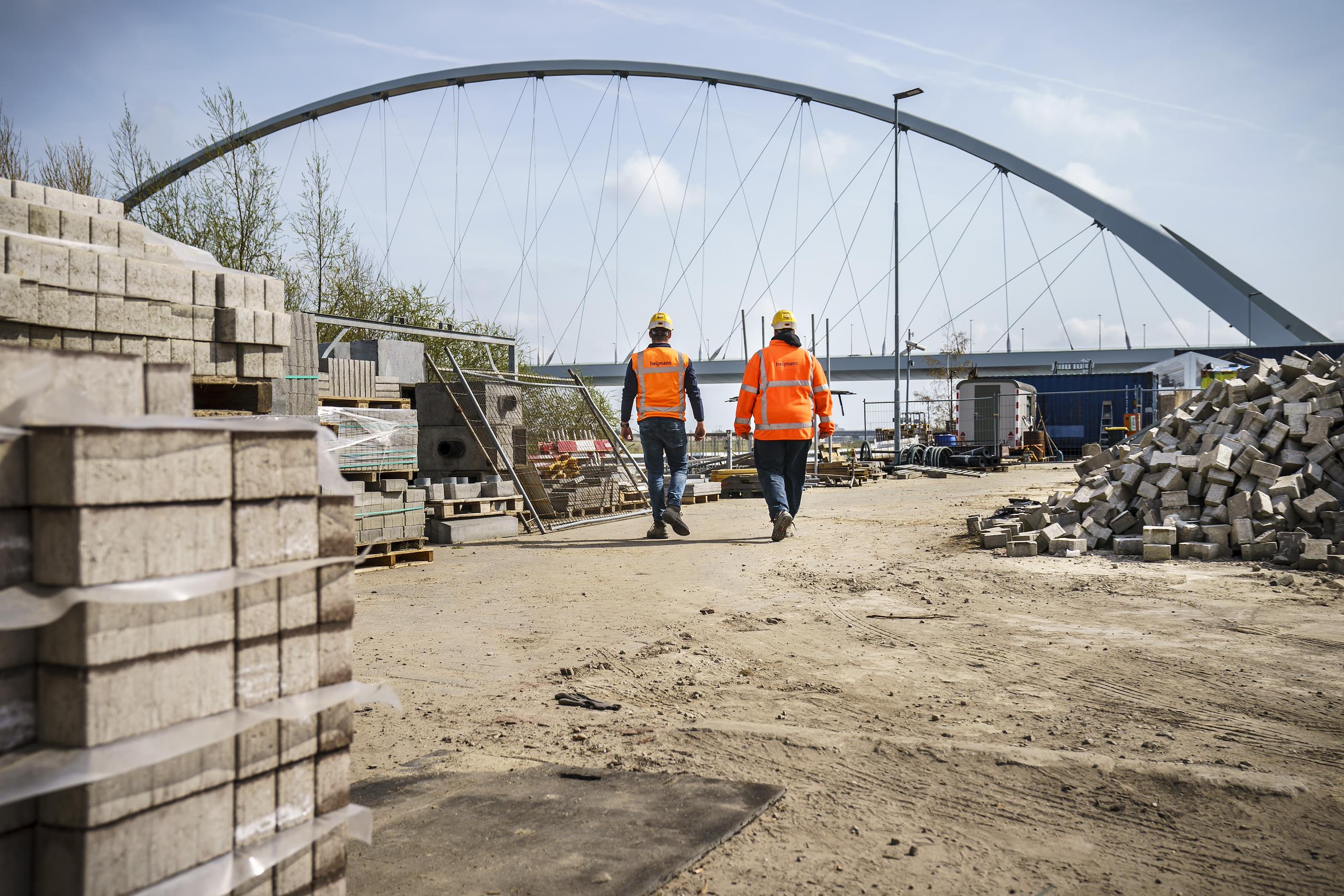As part of our strategy process, in 2022 we conducted a new materiality analysis. As part of this analysis, we identified the aspects through which the organisation has a significant impact on the economy, the environment and people. For the first time, we focused this analysis on so-called double materiality. As a result, the presentation of the matrix also differs from previous years. On the one hand, we have identified aspects that provide insight into how sustainability affects Heijmans’ financial performance. This includes the likes of revenue, capital, equity and reputation. On the other hand, we have also included aspects that provide insight into Heijmans’ impact on the environment, people and society.
Firstly, we listed Heijmans’ most important stakeholders and looked at how best to approach them. The selection of stakeholders is also related to the degree of cooperation with the various stakeholder groups in the value creation model. We then drew up a shortlist of themes based on desk research and identified the material aspects that play a role for Heijmans. In doing so, we took into account industry trends and the issues relevant to clients, investors and other players in the construction industry.
We then engaged with our stakeholders using surveys and interviews to discuss the prioritisation of the substance of these issues and to score their relevance. This meant that the various dialogues always involved clients, cooperation partners, employee representatives and producers/suppliers. Finally, after discussion in the group board, the Executive Board adopted the outcomes. The result of this analysis is shown in the materiality matrix below.

Based on the discussions with stakeholders, the themes of ‘financial health’ and ‘risk management and process improvement’ are material, but not the most material in the matrix. However, from a management responsibility perspective, these two aspects remain a high priority for the Executive Board. The Heijmans Executive Board is aware every single day of the vital importance of risk and financial controls and predictability for the continuity of our organisation. As a project company, we therefore continue to steer closely according to the related KPIs (key performance indicators). Chapters 7 (Results), 10 (Financial statements) and Appendix 11.6.4 (KPI Table) include the performance indicators and notes that can be used to ascertain Heijmans’ financial health.
In the Ministry of Economic Affairs and Climate's most recent Transparency Benchmark - a biennial survey on the reporting transparency of the five hundred largest companies in the Netherlands - Heijmans was ranked a very satisfactory nineteenth place, with the highest rating in the Construction & Maritime category. In the 2021 Tax Transparency Benchmark, we were ranked 48-50.
Explanation of most material themes
1. Energy-neutral building requires the organisation to consider issues such as the positioning of homes, engineering and energy system choices right from the start of the design process. For the aspect of ‘energy-neutral building’, we used to look at the Energy Performance Coefficient for buildings. This building energy efficiency standard gave a good indication of the extent to which buildings were moving towards energy neutrality (EPC=0). In 2021, the government introduced a new system for measuring the energy performance of buildings: the BENG (or near energy-neural buildings) standard. This is not entirely comparable to the EPC system. However, the underlying indicator in both systems is a building’s CO2 emissions, so they are still comparable. In this report, we use the average CO2 emissions of completed residential buildings.

2. Heijmans addresses the theme of ‘nature-inclusive and climate-adaptive building’ in numerous ways. In some projects, such as dyke heightening or water storage, climate resilience is actually the explicit goal of the contract, but we also devote attention to climate adaptability in all our other projects, for example in the rainwater drainage of buildings. Our aim is to apply the NL Greenlabel instrument in all our new area development projects.
Smart water solutions in Sint-Oedenrode
More and more local authorities are looking for solutions to make the living environment resistant to the impact of climate change. This was the case in Sint-Oedenrode, where the local council was looking for a solution to prevent both flooding and drought. Heijmans drew up an integrated plan that links the challenges in different areas. Rainwater no longer disappears into the sewers, but is channelled to a nature area that is too dry. Neighbourhood residents are involved in the project, partly to make them aware of their own role in using rainwater. After all, we are creating a healthy and climate-resilient living environment, and we’re doing it together.
3. The theme of ‘circular construction’ is an integral part of Heijmans’ strategy. When designing and selecting materials for new products, we explicitly take into account material choices, detachability and recyclability. In addition to initiatives in our own operations, we are also in talks with suppliers on the development of circular initiatives, alternative uses for existing products and the reduction of the amount of packaging materials in the chain. A great example of this is the use of circular concrete in a number of projects, including the Rabobank renovation project in Utrecht.
4. Heijmans has embraced ‘the creators of a healthy living environment’ as our ambition. We see this theme as our most important contribution to society. This is also winning recognition externally and we see this reflected in the high levels of appreciation for this theme. Because we are seeing many new developments in the context of this theme, we remain alert to honing our business propositions and using the right performance indicators. Examples of how we have taken concrete steps to put this theme into action include our efforts to build with more consideration for nature inclusivity and climate adaptation. Other examples include our collaborations with conservation and nature organisations and our initiatives to make biodiversity measurable.
5. Heijmans sees the ‘working safely’ theme as one of our top priorities. Apart from the existing SCC (Dutch: VCA) and Safety Ladder certifications for the entire organisation, Heijmans has set up a large-scale safety improvement programme: the Heijmans GO! (no accidents) programme. In recent years, we have developed several innovative solutions as part of this programme, such as the GO! app and the underlying system for reporting unsafe situations. The current programme focuses on additional cultural and behavioural change in the organisation. We also actively participate in industry initiatives to improve safety throughout the chain.
Changes compared with previous years
‘Future-proof construction’ is a new aspect in this terminology and both our management and our stakeholders believe that Heijmans can make a relatively large contribution to a current social issue on this front. ‘Human rights and working conditions in the chain’ has become more important due to emerging legislation on human rights due diligence (such as the EU Taxonomy Minimum Safeguards and the CSDD Directive). Some stakeholders no longer see the use of ‘smart technology’ as distinctive or an end in itself, but more as a means to achieve other objectives, such as the long-term employability of labour, profitability and sustainability. Developing data-driven services, such as Beyond Eyes, to generate client value remains an important part of our innovation efforts. Stakeholders see ‘client-centric service’ as an aspect in which Heijmans’ primary impact is on its own relationships and business performance rather than on society at large.
For further details and performance on the material aspects, please see chapters 6 (Strategy) and 7 (Results) of this annual report. These aspects are also included in the ‘KPI Table’ in Appendix 11.6.4 of this report.